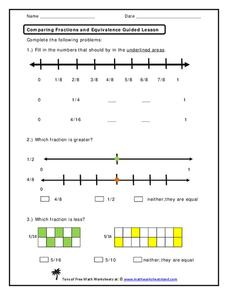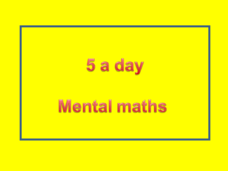Curated OER
Identifying Patterns
Although this fractions exercise may seem difficult at first, it's really quite simple and intended for beginners to mixed numbers. Scholars complete 15 number sequences by adding two or three mixed numbers or decimal numbers. However,...
Curated OER
Counting Forward or Back
What comes next? Young counters follow the stone path to each house, filling in numbers in a sequence as they go. Some of these move forward and some backward, but all progress by ones. Learners start with given numbers and then follow...
Curated OER
Learning 1 - Write the Word
Let's start from the beginning! Young counters complete activities focused on the number one to solidify their understanding of its value. First, they trace its word form and then try it on their own (maybe more than once, even). Next,...
Curated OER
Identifying Patterns
Find the pattern! Eighteen number sequences challenge scholars to identify and complete the pattern, adding at least four digits to the given numbers. All the sequences here involve skip counting by various single-digit numbers,...
Curated OER
Hopping by 2s, part 2
Explore skip counting by twos with young mathematicians as they complete these engaging activities. First, they color in squares to represent counting by twos in an even sequence and an odd sequence. Next, they connect dots (by twos) to...
Curated OER
Counting Up and Down
These number sequences are missing quite a few digits; can your scholars determine some of them? Because learners aren't filling in every blank, they must utilize mental math to determine only the few numbers indicated. They count...
Curated OER
Counting Out Loud
These number sequences are quite fun to look at! Beginning counters complete six of them as they say and write in the numbers. They count only by 1s, however some of these move from greatest to least. The highest number here is 20. Once...
Curated OER
Counting by 1s, 10s, and 100s
These sequences are missing numbers and require some skip counting to complete. Scholars finish rows of numbers first counting by 1s, then 10s, and finally 100s. Each has three given numbers to get them started, and they fill in five...
Curated OER
Counting by 3s, 4s, and 5s
Skip count along the mushrooms to complete these number sentences which give young scholars an introductory look at addition and subtraction. Starting from five double-digit numbers, they subtract or add by threes, fours, and fives to...
Curated OER
Patterns
Follow the pattern to find what comes next. Youngsters analyze shape patterns to continue the sequence in the provided space. The three patterns increase in difficulty, and then scholars have a chance to create two of their own....
Curated OER
What Shapes Can You See?
This clown is missing some things, and young counters sequence single-digit numbers to complete this juggling act. They connect four separate connect-the-dots sequences to create two triangles and two squares, then complete three more...
Curated OER
Comparing Fractions and Equivalence
There are a few ways to practice fraction skills here, and they will all appeal to visual learners. First, mathematicians fill in blanks in two fraction number sequences. Next, they analyze two fractions marked along a number line to...
Curated OER
Morning Math
Get your morning mathematicians thinking with this set of warm-ups. You can do them all in one day, or separate them and have kids do one each day. They will review past concepts and sharpen newer ones with this assortment of problems...
Curated OER
Number Patterns
Which number comes next? The great part about this number sequencing worksheet is that it increases in difficulty so some learners who aren't challenged by the first few will definitely meet their match with the last couple. In each of...
Curated OER
Mental Math: 5 a Day
This is a really cool math resource! There are nineteen different slides containing five math problems each. They are intended to be used as daily math warm ups and address skills such as, addition, problem solving, missing addends, word...
Curated OER
Number Patterns
Spot the pattern! Pupils examine nine patterns using numbers 0-13. There are two blanks for learners to complete the pattern. None of these involve difficult math or complex concepts- this is for young pattern-finders. A bonus question...
Curated OER
Missing Numbers to Twenty
Which number is missing? Beginning counters examine twenty-six number sequences, one for each letter of the alphabet. Each sequence has four numbers, ranging from one to 20. There is one number missing from the sequence, and learners...
Curated OER
Generating Number Sequences
Practicing number sequences, students solve 5 various problems that include determining various number sequences in each. First, they work out what number comes out of each of the given machines. Then, students write down the first five...
Curated OER
Describe the Pattern
In this math worksheet, students examine a series of numbers and determine the pattern. Students write the rule, then give the next numbers in the sequence. There are 15 problems to solve.
Curated OER
Sequence of Numbers
Reinforcing the math terms, "before," "between," and "after," is the focus of this math PowerPoint. Young mathematicians must fill in the missing number in a sequence of numbers shown on each slide. This presentation should provide...
DK Publishing
Sneaky Snakes: Counting, Part 2
Hissss! Practice counting forwards and backwards with a sly assignment. Eight snakes feature number sequences that are missing a few numbers. The beginning numbers vary, and some snakes require counting down. Learners write in the...
Curated OER
Unit 5: Order Whole Numbers in the 100s and 1,000s
There are three quick number ordering activities here for your mathematicians. First, they analyze data on the number of three types of pies sold. Scholars choose from four ordered lists the one showing fewest to most sold. Then, they...
Curated OER
Ordering
Although there isn't much to this number ordering activity, it offers some solid practice in sequencing two and three-digit numbers. For each of the 20 sets of four numbers, learners re-write them in order from least to greatest. All...
Curated OER
Identifying Patterns
Investigators examine the clues to complete 17 sequences by skip counting backwards. There are two examples to get them started, and all of these patterns include the first three numbers but are missing the last five. If you want...

























